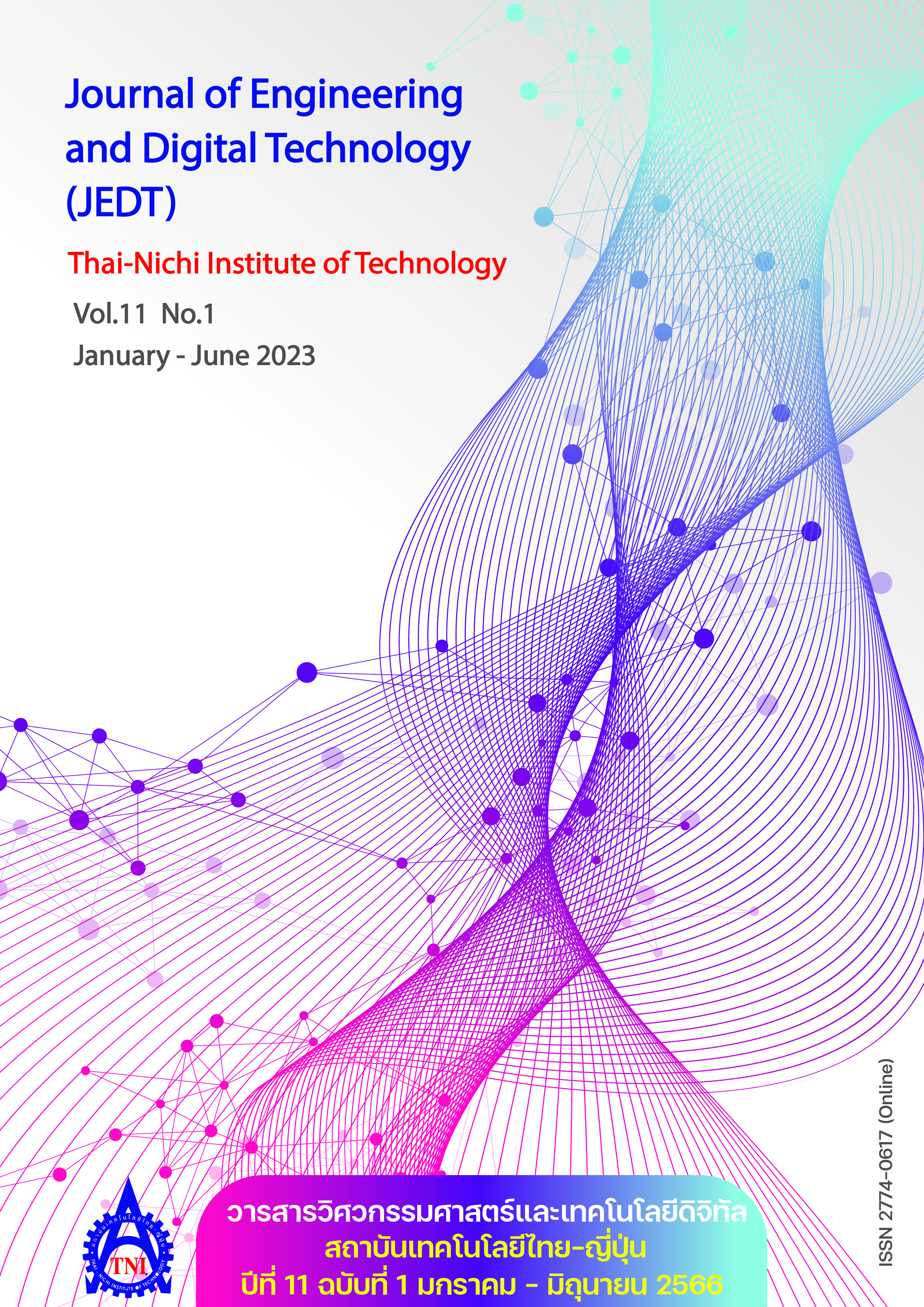Sizing of PV/T Module and Its Cool Water Tank for PV/T-boosted Heat Pump Water Heating: A Case Study of Thailand
Main Article Content
Abstract
The research aims to investigate the potential for hot water production of vapor compression heat pump together with photovoltaic/thermal (PV/T). The heat pump with a maximum heating capacity of 3,000 W extracted heat from each PV/T module of 1.326 m2 in parallel connection that generated a maximum heating capacity of 200 Wp. This study was considered the suitable sizes of PV/T module and cool water tank for hot water production volumes of 350, 500, and 700 liters at 60 °C every day. The amount of heat and electrical energy generated with various PV/T modules, and cool water sizing including the saving of electrical energy from transmission line compare with that from electrical coil for hot water production were investigated under Chiang Mai, Khon Kaen, Bangkok, and Songkhla climates. The result showed that the presented unit could save electrical energy over 90, 90, 70% of the transmission line, respectively. In term of economic analysis, the suitable numbers of PV/T modules with 300, 300, 50 L of cool water tank, respectively, were found and the payback periods were 5.70, 3.95, 4.83 years, respectively.
Article Details

This work is licensed under a Creative Commons Attribution-NonCommercial-NoDerivatives 4.0 International License.
Article Accepting Policy
The editorial board of Thai-Nichi Institute of Technology is pleased to receive articles from lecturers and experts in the fields of engineering and technology written in Thai or English. The academic work submitted for publication must not be published in any other publication before and must not be under consideration of other journal submissions. Therefore, those interested in participating in the dissemination of work and knowledge can submit their article to the editorial board for further submission to the screening committee to consider publishing in the journal. The articles that can be published include solely research articles. Interested persons can prepare their articles by reviewing recommendations for article authors.
Copyright infringement is solely the responsibility of the author(s) of the article. Articles that have been published must be screened and reviewed for quality from qualified experts approved by the editorial board.
The text that appears within each article published in this research journal is a personal opinion of each author, nothing related to Thai-Nichi Institute of Technology, and other faculty members in the institution in any way. Responsibilities and accuracy for the content of each article are owned by each author. If there is any mistake, each author will be responsible for his/her own article(s).
The editorial board reserves the right not to bring any content, views or comments of articles in the Journal of Thai-Nichi Institute of Technology to publish before receiving permission from the authorized author(s) in writing. The published work is the copyright of the Journal of Thai-Nichi Institute of Technology.
References
A. N. Karakilic, A. Karafil, and N. Gene, “Effects of temperature and solar irradiation on performance of monocrystalline, polycrystalline and thin-film PV panels,” IJTPE, vol. 14, no. 2, pp. 254–260, Jun. 2022.
T. Lungkadee and A. Asanakham, “Evaluation of electrical power and temperature of solar rooftop module by air cooling with augmented fin,” Eng. J. Chiang Mai Univ., vol. 28, no. 3, pp. 130–141, 2016.
E. Wilson, “Theoretical and operational thermal performance of a wet crystalline silicon PV module under Jamaican conditions,” Renew. Energy, vol. 34, no. 6, pp. 1655–1660, Jun. 2009.
T. Kim, B. Choi, Y. Han, and K. Do, “A comparative investigation of solar-assisted heat pumps with solar thermal collectors for a hot water supply system,” Energy Convers. Manage., vol. 172, pp. 472–484, Sep. 2018.
M. A. Obalanlege, Y. Mahmoudi, R. Douglas, E. Ebrahimnia-Bajestan, J. Davidson, and D. Bailie, “Performance assessment of a hybrid photovoltaic-thermal and heat pump system for solar heating and electricity,” Renew. Energy, vol. 148, pp. 558–572, Apr. 2020.
S. Vaishak and P. V. Bhale, “Photovoltaic/thermal-solar assisted heat pump system: Current status and future prospects,” Sol. Energy, vol. 189, pp. 268–284, Sep. 2019.
M. Kosan, M. Demirtas, M. Aktas, and E. Disli, “Performance analyses of sustainable PV/T assisted heat pump drying system,” Sol. Energy, vol. 199, pp. 657–672, Mar. 2020.
E. Bellos, C. Tzivanidis, K. Moschos, and K. A. Antonopoulos, “Energetic and financial evaluation of solar assisted heat pump space heating systems,” Energy Convers. Manage., vol. 120, pp. 306–319, Jul. 2016.
Y. Bai, T. T. Chow, C. Menezo, and P. Dupeyrat, “Analysis of a hybrid PV/Thermal solar-assisted heat pump system for sports center water heating application,” Int. J. Photoenergy, vol. 2012, Aug. 2012, Art. no. 265838, doi: 10.1155/2012/265838.
European Commission. “Photovoltaic geographical information systems.” EUROPA.eu. https://re.jrc.ec.europa.eu/pvg_tools/en/ (accessed Aug. 9, 2022).
V. Sun, A. Asanakham, T. Deethayat, and T. Kiatsiriroat, “A new method for evaluating nominal operating cell temperature (NOCT) of unglazed photovoltaic thermal module,” Energy Rep., vol. 6, pp. 1029–1042, Nov. 2020.
K. Utama, “Performance analysis of photovoltaic/thermal module with heat pump for heat and power,” M.S. thesis, Dept. Energy Eng., Chiang Mai Univ., Chiang Mai, Thailand, 2022.


